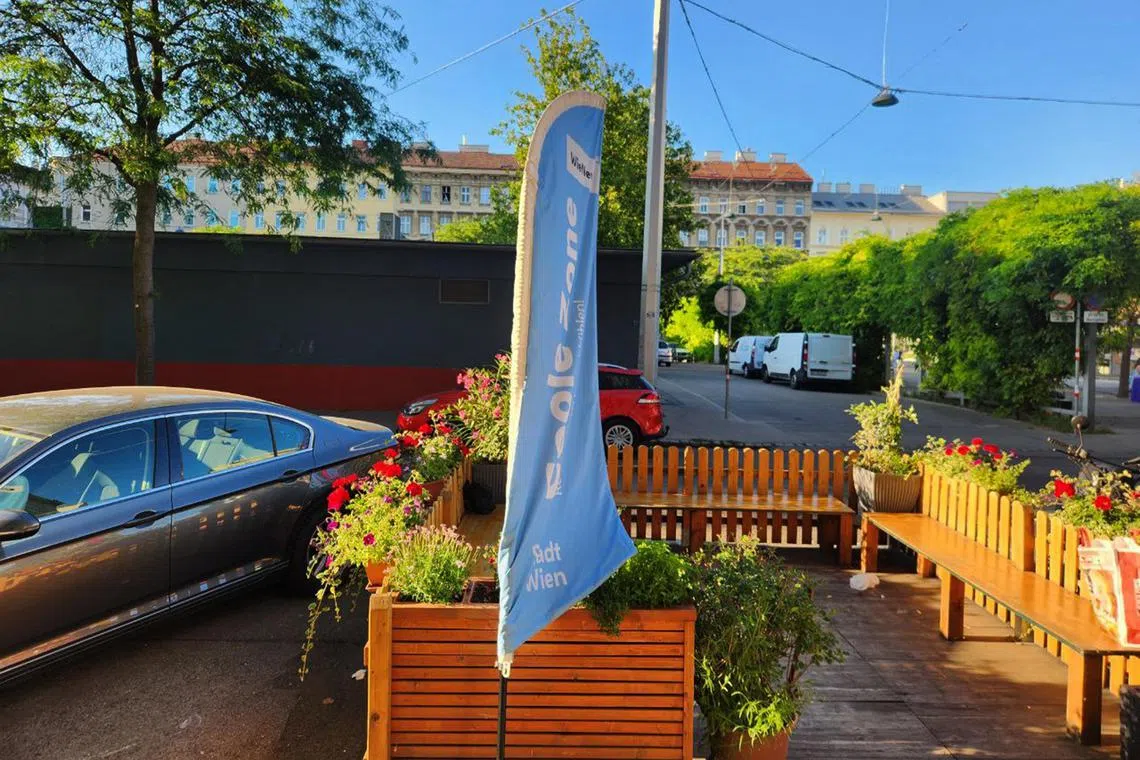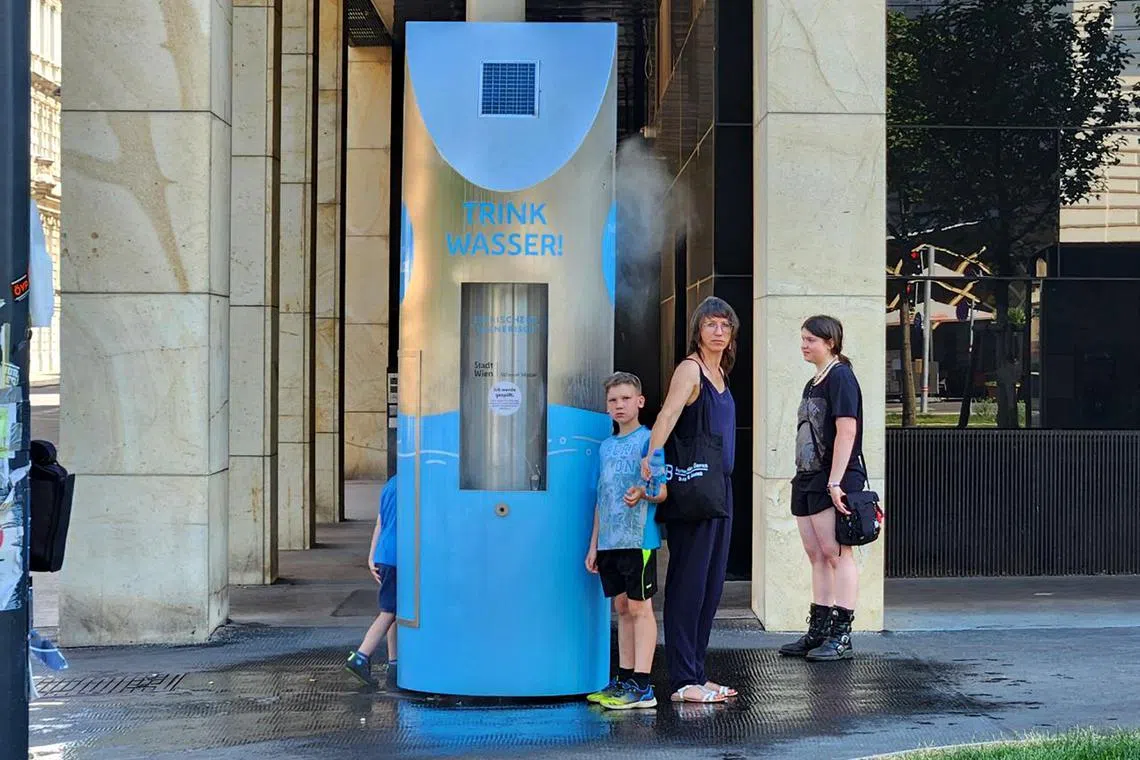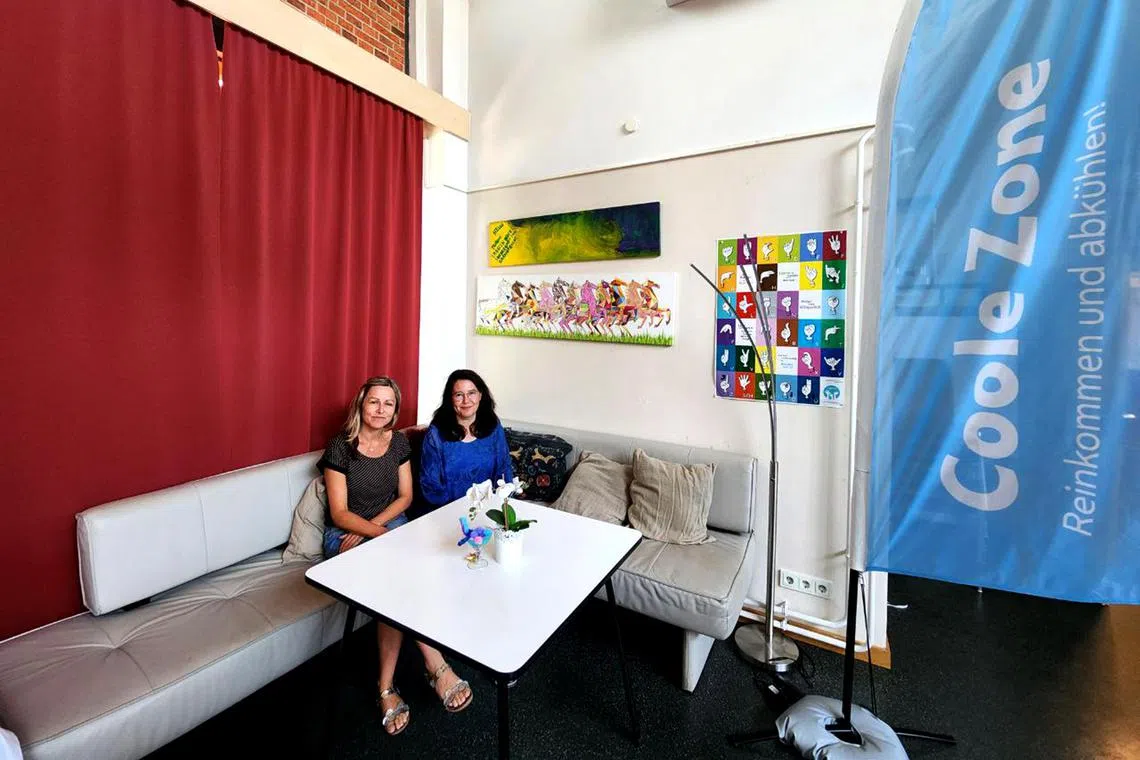‘Cool zones’ in Vienna help Austrians cope with summer heatwave
Sign up now: Get ST's newsletters delivered to your inbox

A cool zone banner outside a social services centre for migrant women in Vienna’s District 2.
ST PHOTO: SHABANA BEGUM
Follow topic:
VIENNA, Austria – College student Marlene Waldner was on her period in the first week of July, which happened to be the hottest summer week of 2025 so far in the capital of music, Vienna.
Daytime temperatures exceeded 30 deg C that week, and the mercury crescendoed past 36 deg C on July 3.
“If it’s very hot, the period cramps get worse and I can’t concentrate,” said Ms Waldner, 25, who is among the majority of Austrians who live in housing without air-conditioning, a norm in much of Europe.
Reprieve, however, came in the form of a small social services centre for migrant women, tucked away in Vienna’s District 2. The centre, called Piramidops, is one of 22 indoor spaces across the city that the authorities have designated as “cool zones” in July and August of 2025.
These include social service organisations, libraries and pensioners’ clubs.
Seeking a comfortable place to work on a group project on July 2, Ms Waldner found out about Piramidops online.
These free air-conditioned spaces are cooled to between 20 deg C and 24 deg C, offering an escape from the searing, harsh heat. This is an expansion of a pilot that started with two centres in the summer of 2023, and more than 10 in 2024.
Ms Waldner and her friends were given lentil stew and pitchers of cool, fruity drinks as they worked on their school project. She said: “I’m definitely going to use these centres more. I don’t even have a fan at home right now.”
Dr Johannes Lutter, senior urban planner at Urban Innovation Vienna – the city’s climate and innovation agency – said: “When it comes to urban heat, what the city needs are rooms and facilities that are open to the public when it gets really hot.
“A large group of the population, and the most vulnerable in particular, are stuck in small apartments. We usually don’t have air-conditioning in Vienna, and if you’re poorly insulated, it really gets hot in those apartments.”

(From left) College students Celine Kovacs, Marlene Waldner and Amelie Henninger in the cool zone at Piramidops on July 2. Such spaces can be found at social service organisations, libraries and pensioners’ clubs.
ST PHOTO: SHABANA BEGUM
When the authorities first conceptualised the idea of cool zones, they eyed larger places like museums, schools and public buildings. But these were not feasible because museums require entrance fees and schools had issues with liability.
“And then we were asking in the community, who had rooms to offer? It was civil society, pensioners’ clubs, libraries (that stepped up)... Next year, we may have companies,” Dr Lutter told the media on July 1, a day before the SMU City Dialogues conference in Vienna.
Singapore unveiled a heatwave plan in March
While shade from trees and green spaces were previously sufficient to shield from the sun, Austria’s summers have been getting hotter amid climate change, said Ms Waldner’s classmate Celine Kovacs, 24.
Much of Europe has been sizzling in a heatwave
As the fiery sun beat down on central Vienna on July 3, pedestrians made a beeline for a water cooler which also doubled as a misting station, spraying fine droplets that help to take heat away from the skin through evaporation.
Such public facilities are part of Vienna’s heat action plan, introduced a few years ago. The city has around 1,600 public drinking fountains and about 100 spray mist stations.

A water cooler in Vienna which doubles as a spray mist station.
ST PHOTO: SHABANA BEGUM

Vienna has about 100 spray mist stations.
ST PHOTO: SHABANA BEGUM
Ms Petra Staduan, 40, has been taking a dip off Danube Island – Vienna’s recreational island at the centre of the Danube River – every two days to cool off.
The university lecturer spent some time in cool zone Club 21 before heading off for a meeting on July 3. The activity centre is open to anyone, but its main function is to serve people with disabilities.
The centre’s staff were preparing for a larger crowd in the afternoon, as the space has been a cool zone for two years.
Club 21 employee Nora Haidowatz said: “For people with mental disabilities, the heat is very bad because it makes them feel worse.”

Vienna’s cool zone Club 21 manager Monika Haider (left) and employee Nora Haidowatz.
ST PHOTO: SHABANA BEGUM
While it is tempting to install air-conditioning in more homes during the summer months, that is not a solution since it contributes to the carbon footprint while releasing waste heat to the surroundings, said Professor Kristina Orehounig from the Vienna University of Technology.
She added that the authorities and researchers have been prioritising passive cooling measures like shading, figuring out proper ventilation and infusing more greenery into the city.
Prof Orehounig was previously a lead of the Cooling Singapore 2.0 project
To combat the city’s urban heat island effect, Vienna has also been aggressively stripping heat-trapping asphalt and concrete from its streets to make way for more trees, cycle paths and cooling water features.
Between 2021 and 2025, the city has implemented more than 320 greening projects under this Get Off The Asphalt initiative.


